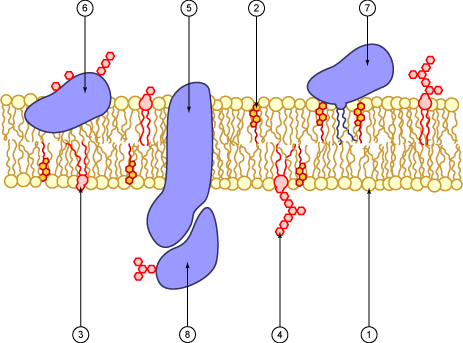1.3 Membrane structure
Phospholipid bilayer
A diagrammatic scheme of a plasma membrane
1. Is the lower layer of the phospholipid bilayer, 2 is a cholesterol molecule, 6 and 8 are peripheral glycoproteins, and 5 is an example of an integral protein and and 7 an example of a peripheral protein. Note that integral proteins are embedded in the phospholipid of the membrane, whereas peripheral proteins are attached to its surface

Phospholipids form bilayers in water due to the amphipathic properties of phospholipid molecules.
Membrane proteins are diverse in terms of structure, position in the
membrane and function.
Cholesterol is a component of animal cell membranes.
Cholesterol in mammalian membranes reduces membrane fluidity and permeability to some solutes.
1.4 Membrane transport
|
Essential idea: Membranes control the composition of cells by active and passive transport. |
|
|
Nature of science: Experimental design—accurate quantitative measurement in osmosis experiments are essential. (3.1) |
|
|
Understandings: Particles move across membranes by simple diffusion, facilitated diffusion, osmosis and active transport. The fluidity of membranes allows materials to be taken into cells by endocytosis or released by exocytosis. Vesicles move materials within cells.
|
|
|
Applications :
Structure and function of sodium–potassium pumps for active transport and potassium channels for facilitated diffusion in axons. Tissues or organs to be used in medical procedures must be bathed in a solution with the same osmolarity as the cytoplasm to prevent osmosis.
Skill: Estimation of osmolarity in tissues by bathing samples in hypotonic and hypertonic solutions. (Practical 2)
|
Guidance: Osmosis experiments are a useful opportunity to stress the need for accurate mass and volume measurements in scientific experiment |
